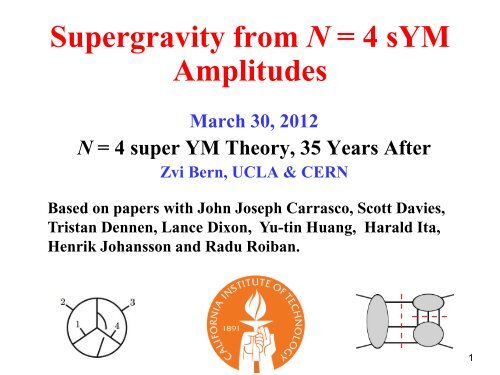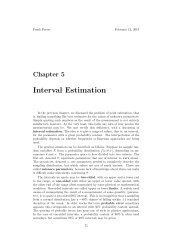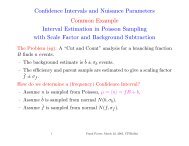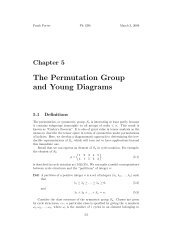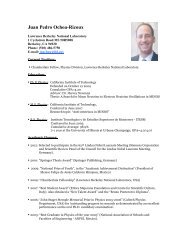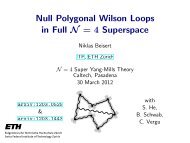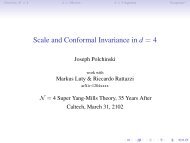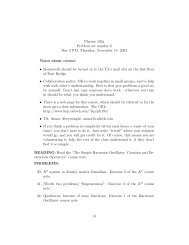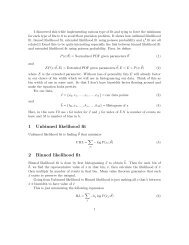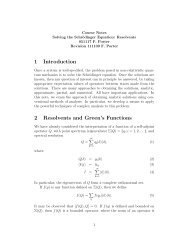Supergravity from N = 4 sYM Amplitudes
Supergravity from N = 4 sYM Amplitudes
Supergravity from N = 4 sYM Amplitudes
Create successful ePaper yourself
Turn your PDF publications into a flip-book with our unique Google optimized e-Paper software.
<strong>Supergravity</strong> <strong>from</strong> N = 4 <strong>sYM</strong><br />
<strong>Amplitudes</strong><br />
March 30, 2012<br />
N = 4 super YM Theory, 35 Years After<br />
Zvi Bern, UCLA & CERN<br />
Based on papers with John Joseph Carrasco, Scott Davies,<br />
Tristan Dennen, Lance Dixon, Yu-tin Huang, Harald Ita,<br />
Henrik Johansson and Radu Roiban.<br />
1
Outline<br />
1) A hidden structure in gauge and gravity amplitudes<br />
— a duality between color and kinematics.<br />
— gravity as a double copy of gauge theory.<br />
2) Examples of theories where duality and double copy<br />
holds.<br />
3) Application: Reexamination of sugra UV divergences<br />
— Lightning review of sugra UV properties.<br />
— A four-loop surprise in N = 8 supergravity.<br />
— A three-loop surprise in N = 4 supergravity.<br />
— Consequences and prospects for future.<br />
2
Nonplanar <strong>Amplitudes</strong><br />
We already heard talks describing ideas for understanding<br />
amplitudes, especially in the planar case.<br />
Nonplanar is less developed than planar but we do have powerful<br />
tools for complete calculations:<br />
• Unitarity Method<br />
• Method of Maximal cuts<br />
ZB, Dixon, Dunbar, Kosower<br />
ZB, Carrasco, Johansson , Kosower<br />
• Duality between color and kinematics<br />
ZB, Carrasco and Johansson<br />
See talks <strong>from</strong> Arkani-Hamed<br />
Volovich and Skinner<br />
In this talk we will explain how N = 4 <strong>sYM</strong> (including non-planar)<br />
helps us study supergravity theories.<br />
3
Gravity vs Gauge Theory<br />
Consider the gravity Lagrangian<br />
flat metric<br />
graviton<br />
field<br />
metric<br />
Infinite number of<br />
complicated interactions<br />
+ …<br />
terrible mess<br />
Non-renormalizable<br />
Compare to Yang-Mills Lagrangian on which QCD is based<br />
Only three and four<br />
point interactions<br />
Gravity seems so much more complicated than gauge theory.<br />
4
Three Vertices<br />
Standard Feynman diagram approach.<br />
Three-gluon vertex:<br />
Three-graviton vertex:<br />
G 3¹®;º¯;¾° (k 1 ; k 2 ; k 3 ) =<br />
About 100 terms in three vertex<br />
Naïve conclusion: Gravity is a nasty mess.<br />
Definitely not a good approach.<br />
5
Simplicity of Gravity <strong>Amplitudes</strong><br />
On-shell viewpoint much more powerful.<br />
On-shell three vertices contains all information:<br />
gauge theory:<br />
gravity:<br />
double copy<br />
of Yang-Mills<br />
vertex.<br />
• Using modern on-shell methods, any gravity scattering<br />
amplitude constructible solely <strong>from</strong> on-shell 3 vertices.<br />
BCFW recursion for trees, BDDK unitarity method for loops.<br />
• Higher-point vertices irrelevant!<br />
6
Gravity vs Gauge Theory<br />
Consider the gravity Lagrangian<br />
flat metric<br />
graviton<br />
field<br />
metric<br />
Infinite number of irrelevant<br />
interactions!<br />
+ …<br />
Simple relation<br />
to gauge theory<br />
Compare to Yang-Mills Lagrangian<br />
Only three-point<br />
Interactions needed<br />
no<br />
Gravity seems so much more complicated than gauge theory.<br />
7
Duality Between Color and Kinematics<br />
Consider five-point tree amplitude:<br />
ZB, Carrasco, Johansson (BCJ)<br />
color factor<br />
kinematic numerator factor<br />
Feynman propagators<br />
c 1 ´ f a 3a 4 b f ba 5c f ca 1a 2<br />
; c 2 ´ f a 3a 4 b f ba 2c f ca 1a 5<br />
; c 3 ´ f a 3a 4 b f ba 1c f ca 2a 5<br />
c 1 ¡ c 2 + c 3 = 0 n 1 ¡ n 2 + n 3 = 0<br />
<br />
Claim: At n-points we can always find a rearrangement so color and<br />
kinematics satisfy the same algebraic constraint equations.<br />
Nontrivial constraints on amplitudes in field theory and string theory<br />
BCJ, Bjerrum-Bohr, Feng,Damgaard, Vanhove, ; Mafra, Stieberger, Schlotterer;<br />
Tye and Zhang; Feng, Huang, Jia; Chen, Du, Feng; Du, Feng, Fu; Naculich, Nastase, Schnitzer<br />
8
BCJ<br />
gauge<br />
theory:<br />
Gravity and Gauge Theory<br />
kinematic numerator<br />
color factor<br />
sum over diagrams<br />
with only 3 vertices<br />
Assume we have:<br />
c 1 + c 2 + c 3 = 0 , n 1 + n 2 + n 3 = 0<br />
Then: c i ) ~n i<br />
gravity:<br />
kinematic numerator of second gauge theory<br />
Proof: ZB, Dennen, Huang, Kiermaier<br />
Gravity numerators are a double copy of gauge-theory ones.<br />
This works for ordinary Einstein gravity and susy versions.<br />
Cries out for a unified description of the sort given by string theory!<br />
9
Gravity From Gauge Theory<br />
BCJ<br />
N = 8 sugra: (N = 4 <strong>sYM</strong>) (N = 4 <strong>sYM</strong>)<br />
N = 4 sugra: (N = 4 <strong>sYM</strong>) (N = 0 <strong>sYM</strong>)<br />
N = 0 sugra: (N = 0 <strong>sYM</strong>) (N = 0 <strong>sYM</strong>)<br />
N = 0 sugra: graviton + antisym tensor + dilaton<br />
10
BLG based on a 3 algebra<br />
Four-term color identity:<br />
Duality for BLG Theory<br />
Bagger,Lambert,Gustavsson (BLG)<br />
D = 3 Chern-Simons gauge theory<br />
color<br />
factors<br />
kinematic<br />
numerators<br />
Such numerators explicitly found at 6 points.<br />
Bargheer, He, and McLoughlin<br />
What is the double copy?<br />
Explicit check at 4 and 6 points shows it is the E 8(8)<br />
N = 16 supergravity of Marcus and Schwarz. Very non-trivial!<br />
A hidden 3 algebra structure exists in this supergravity.<br />
11
Recent String Theory Studies<br />
1) Nontrivial consequences for n-point color-ordered tree amplitudes<br />
First proven using monodromy relations in string theory.<br />
Bjerrum-Bohr, Damgaard,Vanhove; Steiberger; Sondergaard<br />
Also proven using on-shell recursion in field theory.<br />
Feng, Huang , Jia;<br />
Chen, Du, Feng<br />
2) Duality between color and kinematics studied in string theory for<br />
five-point trees. Heterotic string especially insightful treatment.<br />
Tye and Zhang; Mafra, Schlotterer Stieberger Bjerrum-Bohr, Damgaard, Vanhove, Sondergaard.<br />
BCJ<br />
3) Helps organize construction of tree and one-loop amplitudes in<br />
string theory.<br />
Mafra, Schlotterer and Stieberger; Mafra and Schlotterer<br />
String theory offers an important handle for understanding<br />
and applying duality between color and kinematics.<br />
12
ZB, Carrasco, Johansson (2010)<br />
Loop-Level Conjecture<br />
sum is over<br />
diagrams<br />
kinematic<br />
numerator<br />
color factor<br />
gauge theory<br />
propagators<br />
gravity<br />
symmetry<br />
factor<br />
Loop-level is identical to tree-level one except for symmetry<br />
factors and loop integration.<br />
Double copy works if numerator satisfies duality.<br />
13
BCJ<br />
Nonplanar <strong>from</strong> Planar<br />
Planar determines nonplanar<br />
• We can carry advances <strong>from</strong> planar sector to the<br />
nonplanar sector.<br />
• Yangian symmetry and integrability clearly has echo in<br />
nonplanar sector because it is built directly <strong>from</strong> planar.<br />
• Only at level of the integrands, so far, but bodes well for the<br />
future.<br />
14
BCJ<br />
Gravity <strong>from</strong> Gauge Theory <strong>Amplitudes</strong><br />
If you have a set of duality satisfying numerators.<br />
To get:<br />
gauge theory<br />
simply take<br />
gravity theory<br />
color factor<br />
kinematic numerator<br />
Gravity loop integrands are free!<br />
15
Explicit Three-Loop Construction<br />
ZB, Carrasco, Johansson (2010)<br />
For N=4 <strong>sYM</strong> we have the<br />
abililty to go to high loop<br />
orders. Go to 3 loops.<br />
(1 & 2 loops works.)<br />
Calculation very similar to earlier<br />
one with Dixon and Roiban, except<br />
now make the duality manifestly<br />
• Duality works!<br />
• Double copy works!<br />
16
ZB, Carrasco, Johansson (2010)<br />
One diagram to rule them all<br />
N = 4 super-Yang-Mills integrand<br />
Diagram (e)<br />
is the master<br />
diagram.<br />
Determine the<br />
master integrand<br />
in proper form<br />
and duality<br />
gives all others.<br />
N = 8 sugra given<br />
by double copy.<br />
17
One diagram to rule them all<br />
triangle subdiagrams<br />
vanish in N = 4 <strong>sYM</strong><br />
All numerators solved in terms of numerator (e)<br />
18
BCJ<br />
Bern, Dennen, Huang, Kiermaier<br />
Tye and Zhang<br />
gauge theory<br />
Generalized Gauge Invariance<br />
Above is just a definition of generalized gauge invariance<br />
gravity<br />
(c ® + c¯ + c ° )f(p i ) = 0<br />
• Gravity inherits generalized gauge invariance <strong>from</strong> gauge theory!<br />
• Double copy works even if only one of the two copies has duality<br />
manifest!<br />
• Used to find expressions for N ¸ 4 supergravity amplitudes at<br />
1, 2 loops. ZB, Boucher-Veronneau and Johansson; Boucher-Veroneau and Dixon<br />
19
Application: UV Properties of Gravity<br />
20
UV properties of gravity<br />
Study of UV divergences in gravity has a long history.<br />
Here, I will only skim over the history.<br />
We study this issue not because we think a finite theory of<br />
gravity immediately gives a good description of Nature—long list<br />
of nontrivial issues.<br />
We study it because the theory can only be finite due<br />
to a fantastic new symmetry or dynamical mechanism.<br />
21
Power Counting at High Loop Orders<br />
Dimensionful coupling<br />
Gravity:<br />
Gauge theory:<br />
Extra powers of loop momenta in numerator<br />
means integrals are badly behaved in the UV.<br />
Non-renormalizable by power counting.<br />
Reasons to focus on N = 8 supegravity:<br />
• With more susy expect better UV properties.<br />
• High symmetry implies technical simplicity.<br />
22
Where is First Potential UV Divergence in D= 4 N = 8 Sugra?<br />
Various opinions, pointing to divergences over the years:<br />
3 loops Superspace power counting Deser, Kay (1978)<br />
Green, Schwarz, Brink (1982)<br />
Howe and Stelle (1989)<br />
Marcus and Sagnotti (1985), etc<br />
5 loops Partial analysis of unitarity cuts; If N = 6 harmonic<br />
superspace exists; algebraic renormalisation argument<br />
Bern, Dixon, Dunbar,<br />
Perelstein, Rozowsky (1998)<br />
Howe and Stelle (2003,2009)<br />
6 loops If N = 7 harmonic superspace exists Howe and Stelle (2003)<br />
7 loops If offshell N = 8 superspace exists;<br />
lightcone gauge locality arguments;<br />
Algebraic renormalization arguments;<br />
E 7(7) symmetry.<br />
8 loops Explicit identification of potential susy invariant<br />
counterterm with full non-linear susy and duality.<br />
Grisaru and Siegel (1982);<br />
Howe, Stelle and Bossard (2009)<br />
Vanhove; Bjornsson, Green (2010)<br />
Kiermaier, Elvang, Freedman(2010)<br />
Ramond, Kallosh (2010);<br />
Biesert, et al (2010)<br />
Kallosh; Howe and Lindström<br />
(1981)<br />
9 loops Assumes Berkovits’ superstring non-renormalization<br />
theorems carries over to D=4 N = 8 supergravity and<br />
extrapolates to 9 loops.<br />
Green, Russo, Vanhove (2006)<br />
(retracted)<br />
No divergences demonstrated above. Arguments based on lack of symmetry<br />
protection. An unaccounted symmetry can make the theory finite.<br />
To end debate we need solid calculations.<br />
23
Complete Three-Loop Result<br />
Analysis of unitarity cuts shows highly nontrivial all loop<br />
cancellations.<br />
To test completeness of cancellations, we decided to directly<br />
calculate potential three-loop divergence.<br />
ZB, Dixon and Roiban (2006); ZB, Carrasco, Forde, Ita, Johansson (2007)<br />
ZB, Carrasco, Dixon, Johansson,<br />
Kosower, Roiban (2007)<br />
Three loops is not only<br />
ultraviolet finite it is<br />
“superfinite”— finite for<br />
D < 6.<br />
It is very finite!<br />
Obtained via on-shell unitarity method:<br />
24
Four-Loop Amplitude Construction<br />
ZB, Carrasco, Dixon, Johansson, Roiban<br />
Get 50 distinct diagrams or integrals (ones with two- or<br />
three-point subdiagrams not needed).<br />
Integral<br />
leg perms<br />
symmetry factor<br />
UV finite for D < 11/2<br />
It’s very finite!<br />
Originally took more than a year.<br />
Today with the double copy we can reproduce it in a couple<br />
of days! Another non-trivial example.<br />
25
Recent Status of Divergences<br />
Consensus that in N = 8 supergravity trouble starts at 5 loops<br />
and by 7 loops we have valid UV counterterm in D = 4<br />
under all known symmetries (suggesting divergences) .<br />
Bossard, Howe, Stelle; Elvang, Freedman, Kiermaier; Green, Russo, Vanhove ; Green and Bjornsson ;<br />
Bossard , Hillmann and Nicolai; Ramond and Kallosh; Broedel and Dixon; Elvang and Kiermaier;<br />
Beisert, Elvang, Freedman, Kiermaier, Morales, Stieberger<br />
For N = 8 sugra in D = 4:<br />
• All counterterms ruled out until 7 loops!<br />
• Candidate 7 loop superspace volume counterterm vanishes.<br />
• But D 8 R 4 apparently available at 7 loops (1/8 BPS) under all<br />
known symmetries. (No known nonrenormalization theorem)<br />
Bossard, Howe, Stelle and Vanhove<br />
For N = 4 sugra in D = 4:<br />
• Again superpace volume vanishes.<br />
• But R 4 apparently available at 3 loops (1/4 BPS) under all<br />
known symmetries.<br />
• A three-loop divergence was expected by everyone.<br />
26
27<br />
Where are N = 8 supergravity Divergences<br />
ZB, Carrasco, Dixon, Johansson, Roiban<br />
Where are the divergences?<br />
Place your bets on D 8 R 4 counterterm:<br />
• At 5 loops in D = 24/5 does N = 8 supergravity diverge?<br />
• At 7 loops in D = 4 does N = 8 supergravity diverge?<br />
A reasonable person would bet for divergences.<br />
But is it right?<br />
To settle bets we need calculations.
ZB, Carrasco, Dixon, Johansson, Roiban (2012)<br />
Critical dimension D =11/2.<br />
Express UV divergences<br />
in terms of vacuum like integrals.<br />
gauge theory<br />
New Four-Loop Surprise<br />
doubled propagator<br />
gravity<br />
same<br />
divergence<br />
• Gravity UV divergence is directly proportional to subleading<br />
color single-trace divergence of N = 4 super-Yang-Mills theory.<br />
• Same happens at 1-3 loops.<br />
28
Calculation of N = 4 <strong>sYM</strong> 5 Loop Amplitude<br />
ZB, Carrasco, Dixon, Johansson, Roiban<br />
Key step for N = 8 supergravity is construction of<br />
complete nonplanar 5 loop integrand of N = 4<br />
<strong>sYM</strong> theory. (Still need to find BCJ form).<br />
Leading color<br />
part:<br />
450 such diagrams with ~100s terms each<br />
Expanding planar in small external momenta and<br />
simplifying via ibp relations: 1 vaccum diagram<br />
Diverges in D = 26/5<br />
Proves finiteness bound saturated<br />
Subleading color part:<br />
Still simplifying<br />
+ …<br />
finite in D = 26/5<br />
29
Stay tuned.<br />
We are going to calculate the UV properties<br />
of N = 8 supergravity at five loops.<br />
30
N = 4 <strong>Supergravity</strong><br />
N = 4 sugra at 3 loops ideal test case to study.<br />
ZB, Davies, Dennen, Huang<br />
Consensus had it that a valid R 4<br />
counterterm exists for this theory in D = 4.<br />
Analogous to 7 loop counterterm of N = 8.<br />
Bossard, Howe, Stelle; Bossard, Howe, Stelle, Vanhove<br />
A no lose calculation:<br />
Either we find first example of a D = 4 divergence or once<br />
again we show an expected divergence is not present.<br />
Duality between color and kinematics<br />
gives us the ability to do the calculation.<br />
31
Three-loop Construction<br />
ZB, Davies, Dennen, Huang<br />
N = 4 sugra : (N = 4 <strong>sYM</strong>) x (N = 0 YM)<br />
• For N = 4 <strong>sYM</strong> copy use<br />
known BCJ representation.<br />
• What representation should<br />
we use for pure YM side?<br />
BCJ form of the<br />
N = 4 <strong>sYM</strong><br />
integrand<br />
32
Three-loop N = 4 supergravity<br />
What is a convenient representation for pure YM copy?<br />
Answer: Feynman diagrams.<br />
Yes, I did say Feynman diagrams!<br />
However, this case is very special.<br />
• We can drop all Feynman diagrams where corresponding N = 4<br />
numerators vanish.<br />
• Gauge-theory Feynman diagrams far simpler than gravity ones.<br />
• We need only the leading UV parts (though we initially keep all<br />
pieces).<br />
• Completely straightforward. Faster to just do it than to argue<br />
about which way might be better.<br />
33
Three-Loop Construction<br />
N = 4 sugra : (N = 4 <strong>sYM</strong>) x (N = 0 YM)<br />
N = 4 <strong>sYM</strong><br />
pure YM<br />
» l ¢ k s 2 tA tree<br />
4 » (" i ¢ l) 4 l 4<br />
N = 4 sugra linear<br />
divergent<br />
Z<br />
(d D l) 3 k7 l 9<br />
BCJ<br />
Feynman<br />
representation representation<br />
Pure YM 4 point amplitude has never been done at three loops.<br />
l 20<br />
simple to see<br />
finite for N=5,6<br />
sugra<br />
Integrals have subdivergences which causes complications.<br />
But this was well understood 30 years ago by Marcus and Sagnotti.<br />
34
The N = 4 <strong>Supergravity</strong> UV Cancellation<br />
ZB, Davies, Dennen, Huang<br />
Spinor helicity used to clean up<br />
Sum over diagrams is gauge invariant<br />
All divergences cancel completely!<br />
It is UV finite contrary to expectations<br />
35
Explanations?<br />
Key Question: Is there an ordinary symmetry<br />
explanation for this?<br />
Or is something extraordinary happening?<br />
• Non-renormalization understanding<br />
<strong>from</strong> heterotic string.<br />
• Quantum corrected duality<br />
current nonconservation.<br />
Tourkine and Vanhove (2012)<br />
Kallosh (2012)<br />
• Why don’t similar cancellations happen for N = 8 supergravity,<br />
killing potential 7 loop counterterm?<br />
• Further explicit calculations needed to help settle the UV<br />
properties and settle various bets.<br />
36
D = 5 UV Properties of Planar N = 4 <strong>sYM</strong><br />
Construction of planar N = 4 <strong>sYM</strong> integrand now very simple<br />
due to dual conformal symmetry.<br />
see talks <strong>from</strong> Arkani-Hamed,<br />
Skinner, Volovich<br />
It was suggested that N = 4 <strong>sYM</strong> in D =5 might be UV finite, based<br />
on connection to D=6 (2,0) theory.<br />
First potential UV divergence in D = 5 sits at 6 loops<br />
Other integrand constructions. All agree.<br />
+ 67 other dual<br />
conformal diagrams<br />
ZB, Carrasco, Dixon, Douglas, Johansson, von Hippel<br />
After expanding in external momenta and simplifying, not vanishing<br />
and not positive definite: no quick way to get the answer.<br />
Nontrivial part is to integrate at 6 loops.<br />
Douglas;<br />
Lambert, Papageorgakis, Schmidt-Sommerfeld,<br />
Bourjaily, DiRe, Shaikh, Spradlin, Volovich<br />
Eden, Heslop, Korchemsky, Sokatchev<br />
Checked to be valid for D < 6<br />
ZB, Carrasco, Dennen, Huang, Ita<br />
Michael Douglas and Matt von Hippel heroically integrating this.<br />
We should be hearing a final verdict <strong>from</strong> them soon…<br />
37
Summary<br />
•A new duality conjectured between color and kinematics.<br />
Locks down the multiloop structure of integrands of amplitudes.<br />
• When duality between color and kinematics manifest, gravity<br />
integrands follow immediately <strong>from</strong> gauge-theory ones.<br />
• Duality exists outside ordinary gauge theories. BLG theory.<br />
• Double copy gives us a powerful way to explore the UV properties<br />
of gravity theories.<br />
• N = 4 sugra has no three-loop four-point divergence, contrary<br />
to expectations <strong>from</strong> symmetry considerations.<br />
• Power counting using known symmetries and their known<br />
consequences can be misleading. Concrete example.<br />
Duality between color and kinematics offers a powerful new way to<br />
explore gauge and gravity theories at high loop orders, in particular<br />
their UV properties. N = 4 <strong>sYM</strong> is a crucial ingredient in these<br />
studies.<br />
38
Extra Slides<br />
39
Trace representations of Gravity <strong>Amplitudes</strong><br />
Duality between color and kinematics also found for trace<br />
representations.<br />
ZB and Dennen<br />
Tree-level trace representation:<br />
f 3 with group<br />
theory factors<br />
Nontrivial duality (tested through 9 points)<br />
Gravity amplitude:<br />
kinematic<br />
¿<br />
dual to traces<br />
replace color trace with t<br />
One-loop examples using fundamental or adjoint trace<br />
representation in N ¸ 4 supergravity.<br />
ZB, Dennen;<br />
ZB, Boucher-Veronneau and Johansson<br />
40
Does it work? Test at 1, 2 loops<br />
Multiloop N = 4 supergravity<br />
One-loop: keep only box Feynman diagrams<br />
stA tree<br />
4 £ F<br />
+ perms = 0 ² + ¯nite<br />
N = 0 Feynman<br />
diagram, including<br />
ghosts<br />
Two-loop: keep only double box Feynman diagrams<br />
N = 4 <strong>sYM</strong> box<br />
numerator<br />
All pure supergravities<br />
finite at 1,2 loops<br />
Becomes gauge<br />
invariant after<br />
permutation sum.<br />
s 2 tA tree<br />
4 £ + s 2 tA tree<br />
F F + perms = 0 ²<br />
4 £<br />
Feynman diagram<br />
including ghosts<br />
Get correct results. Who would have imagined it is<br />
this simple to get gravity results?<br />
+ finite<br />
41
Dealing With Subdivergences<br />
Marcus, Sagnotti (1984)<br />
The problem was solve nearly 30 years ago.<br />
Recursively subtract all subdivergences.<br />
regulator dependent<br />
reparametrize<br />
subintegral<br />
Regulator Independent<br />
Nice consistency check: all log(m) terms must cancel<br />
Extracting UV divergence in the presence of UV subdivergences<br />
and IR divergences is a well understood problem.<br />
42
Integral Basis<br />
Using FIRE we obtain a basis of integrals:<br />
Use Mellin-Barnes resummation of residues method of Davydychev and<br />
Kalmykov on all but last integral. Last one doable by staring at paper <strong>from</strong><br />
Grozin or Smirnov’s book (easy because no subdivergences).<br />
43
Loop Cancellations in Pure Gravity<br />
Powerful new one-loop integration method due to Forde makes<br />
it much easier to track the cancellations. Allows us to link<br />
one-loop cancellations to tree-level cancellations.<br />
Observation: Most of the one-loop cancellations<br />
observed in N = 8 supergravity leading to “no-triangle<br />
property” are already present in non-susy gravity.<br />
n<br />
legs<br />
maximum powers of<br />
loop momenta<br />
Cancellation generic<br />
to Einstein gravity<br />
Cancellation <strong>from</strong> N = 8 susy<br />
ZB, Carrasco, Forde, Ita, Johansson<br />
Proposal: This continues to higher loops, so that most of the<br />
observed N = 8 multi-loop cancellations are not due to susy but<br />
in fact are generic to gravity theories!<br />
All loop finiteness of N = 8 supergravity would follow <strong>from</strong> a<br />
combination of susy cancellations on top of novel but generic<br />
cancellations present even in pure Einstein gravity.<br />
44
N = 8 L-Loop UV Cancellations<br />
2 3<br />
..<br />
1<br />
4<br />
From 2 particle cut:<br />
numerator factor<br />
1 in N = 4 YM<br />
L-particle cut<br />
ZB, Dixon, Roiban<br />
numerator factor<br />
• Numerator violates one-loop “no-triangle” property.<br />
• Too many powers of loop momentum in one-loop subamplitude.<br />
• After cancellations behavior is same as in N = 4 Yang-Mills!<br />
• UV cancellation exist to all loop orders! (not a proof of finiteness)<br />
• These all-loop cancellations not explained by any known<br />
supersymmetry arguments.<br />
• Existence of these cancellations drive our calculations!<br />
45
Lagrangians<br />
ZB, Dennen, Huang, Kiermaier<br />
arXiv:1004.0693<br />
How can one take two copies of the gauge-theory Lagrangian<br />
and get a gravity Lagrangian?<br />
Add zero to the YM Lagrangian in a special way:<br />
= 0<br />
Through five points:<br />
• Feynman diagrams satisfy the color-kinematic duality.<br />
• Introduce auxiliary field to convert nonlocal interactions<br />
into local three-point interactions.<br />
• Take two copies: you get gravity!<br />
At each order need to add more and more vanishing terms.<br />
46
Symmetries<br />
Monteiro and O’Connell<br />
Consider self dual YM. Work in space-cone gauge of<br />
Chalmers and Siegel<br />
u = t ¡ z<br />
w = x + iy<br />
Generators of diffeomorphism invariance:<br />
The Lie Algebra:<br />
YM vertex<br />
The X(p 1 , p 2 ) are YM vertices, valid for self-dual configurations.<br />
Explains why numerators satisfy Jacobi Identity<br />
YM inherits diffeomorphism symmetry of gravity!<br />
We need to go beyond self dual.<br />
Recent progress <strong>from</strong> Bjerrum-Bohr, Damgaard, Monteiro and O’Connell<br />
47


